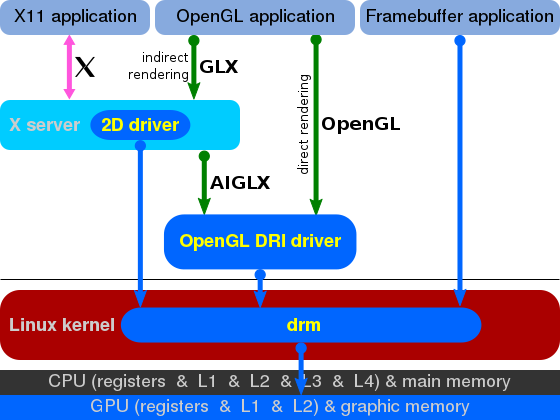Linux graphics stack
2D图形架构
早期Linux图形系统的显示全部依赖X Server,X Client调用Xlib提供的借口向 X Server发送渲染命令,X Server根据 X Client的命令请求向硬件设备绘制图形,X Client与X Server之间通过X11协议通讯。通过这种方式,X Server屏蔽了所有的硬件差异,保证同一个X程序能够在不同的硬件设备上运行。
X Server需要与多种多样的硬件打交道,每个硬件提供自己的DDX驱动程序,X Server最后调用DDX的接口将图形发送给硬件设备。

3D图形架构
通过3D硬件执行3D加速能够大大提高绘制效率,根据不同的模式有两种架构:
Indirect Rendering
这种模式下,仅仅X Server能够访问3D硬件设备,X Client需要绘图时通过X11扩展协议将3D命令发送给X Server,然后由X Server控制3D硬件设备执行,这种模式称为“非直接渲染”。
这种模式与2D模式类似。

但是这种模式无法发挥出3D硬件的效率
Direct Rendering
DRI(Direct Rendering Infrastructure)架构允许X Client直接控制3D硬件设备,所以这种模式下要求X Client与X Server必须位于同一个设备上。
DRM(Direct Rendering Manager)是DRI架构下的Kernel实现,DRM负责:hardware locking, access synchronization, video memory and more.
DRM also provides userspace with an API that it can use to submit commands and data in a format that is adequate for modern GPUs, which effectively allows userspace to communicate with the graphics hardware.
Notice that many of these things have to be done specifically for the target hardware so there are different DRM drivers for each GPU.

DRI/DRM provide the building blocks that enable userspace applications to access the graphics hardware directly in an efficient and safe manner, but in order to use OpenGL we need another piece of software that, using the infrastructure provided by DRI/DRM, implements the OpenGL API while respecting the X server requirements.
Mesa
Mesa is a free software implementation of the OpenGL specification, and as such, it provides a libGL.so, which OpenGL based programs can use to output 3D graphics in Linux. Mesa can provide accelerated 3D graphics by taking advantage of the DRI architecture to gain direct access to the underlying graphics hardware in its implementation of the OpenGL API.
When our 3D application runs in an X11 environment it will output its graphics to a surface (window) allocated by the X server. Notice, however, that with DRI this will happen without intervention of the X server, so naturally there is some synchronization to do between the two, since the X server still owns the window Mesa is rendering to and is the one in charge of displaying its contents on the screen. This synchronization between the OpenGL application and the X server is part of DRI. Mesa’s implementation of GLX (the extension of the OpenGL specification that addresses the X11 platform) uses DRI to talk to the X server and accomplish this.
Mesa also has to use DRM for many things. Communication with the graphics hardware happens by sending commands (for example “draw a triangle”) and data (for example the vertex coordinates of the triangle, their color attributes, normals, etc). This process usually involves allocating a bunch of buffers in the graphics hardware where all these commands and data are copied so that the GPU can access them and do its work. This is enabled by the DRM driver, which is the one piece that takes care of managing video memory and which offers APIs to userspace (Mesa in this case) to do this for the specific target hardware. DRM is also required whenever we need to allocate and manage video memory in Mesa, so things like creating textures, uploading data to textures, allocating color, depth or stencil buffers, etc all require to use the DRM APIs for the target hardware.

引用原文:https://blogs.igalia.com/itoral/2014/07/29/a-brief-introduction-to-the-linux-graphics-stack/
Linux graphics stack的更多相关文章
- Monitoring and Tuning the Linux Networking Stack: Receiving Data
http://blog.packagecloud.io/eng/2016/06/22/monitoring-tuning-linux-networking-stack-receiving-data/ ...
- Queueing in the Linux Network Stack !!!!!!!!!!!!!!!
https://www.coverfire.com/articles/queueing-in-the-linux-network-stack/ Queueing in the Linux Networ ...
- Linux Storage Stack Diagram存储堆栈图
这是一个描述非常好的存储栈,版本为:Linux Storage Stack Diagram v4.10,我在这里转载下图片,可以提升大家对存储栈的理解. https://www.thomas-kren ...
- Linux Kernel Stack
整理一些杂乱的内容.以下x86架构. Linux 内核栈大小 内核栈大小是固定的,默认为8k,曾经有选项可以设置为4k栈.由于大小固定,申请过大的栈内存,或者函数调用层次过深,都可能导致栈溢出. 关注 ...
- 《Monitoring and Tuning the Linux Networking Stack: Receiving Data》翻译
Overview 从宏观的角度来看,一个packet从网卡到socket接收缓冲区的路径如下所示: 驱动加载并初始化 packet到达网卡 packet通过DMA被拷贝到内核中的一个ring buff ...
- The Linux Storage Stack Diagram
相关文章: 如何提高Linux下块设备IO的整体性能?
- linux io stack
- The Linux Storage Stack Diagram 内核 4.0 版的 I/O 栈
- Linux Storage Stack Diagram 4.0
https://www.thomas-krenn.com/en/wiki/Linux_Storage_Stack_Diagram
随机推荐
- xxl-job之实现流程任务编排思路
背景 某一天一如既往的上班"旅途"中,我的领导在开早会的时候,说我最近没啥事,于是让我研究一下Activiti工作流引擎与Drools规则引擎,当时也不知道后边具体要做什么,管 ...
- 使用Observer实现HBase到Elasticsearch的数据同步
最近在公司做统一日志收集处理平台,技术选型肯定要选择elasticsearch,因为可以快速检索系统日志,日志问题排查及功业务链调用可以被快速检索,公司各个应用的日志有些字段比如说content是不需 ...
- 2019牛客暑期多校训练营(第五场)H.subsequence 2(拓扑)
题意:给你一个字符串的长度n 现在询问了m*(m-1)/2次 每次都可以询问两个字符 然后 会告诉你只留下这两个字符后 字符串的样子 现在问你能不能还原字符串 如果能就输出字符串 否则输出-1 思路: ...
- Educational Codeforces Round 67 E.Tree Painting (树形dp)
题目链接 题意:给你一棵无根树,每次你可以选择一个点从白点变成黑点(除第一个点外别的点都要和黑点相邻),变成黑点后可以获得一个权值(白点组成连通块的大小) 问怎么使权值最大 思路:首先,一但根确定了, ...
- Codeforces Global Round 7 B. Maximums(逻辑)
题意: 有数组 an,定义 xi 为 a 的前 i - 1 位的最大值(x0 = 0),定义 bi 为 ai - xi,给出数组 bn,还原数组 an. 思路: 因为 x0 = 0,所以 b0 = a ...
- 【uva 714】Copying Books(算法效率--二分+贪心)
题意:将1个含N个正整数的序列划分成K个连续的子序列,使每段的和的最大值尽量小,问字典序最小的划分方案. 解法:由于是连续的数的"最大值最小",便可想到二分每段的最大值,若这时可分 ...
- Codeforces Round #307 (Div. 2) B. ZgukistringZ
Professor GukiZ doesn't accept string as they are. He likes to swap some letters in string to obtain ...
- Light Bulb ZOJ - 3203 三分
三分: 和二分非常类似的一个算法,与二分不同的是 二分是单调的,而三分是一个先增后减或者先减后增 三分可以求出峰值. 注意三分一定是严格单调的,不能有相等的情况. 讲个例题: 题目 题意: 一个人发现 ...
- Codeforces Round #Pi (Div. 2) D. One-Dimensional Battle Ships
Alice and Bob love playing one-dimensional battle ships. They play on the field in the form of a lin ...
- 如何安装Gephi工具
gephi中文版是一款开源免费跨平台基于JVM的复杂网络分析软件,安装后需要安装Java jdk API,否则就会出现gephi打不开的情况 该工具主要用于各种网络和复杂系统,动态和分层图的交互可视化 ...
